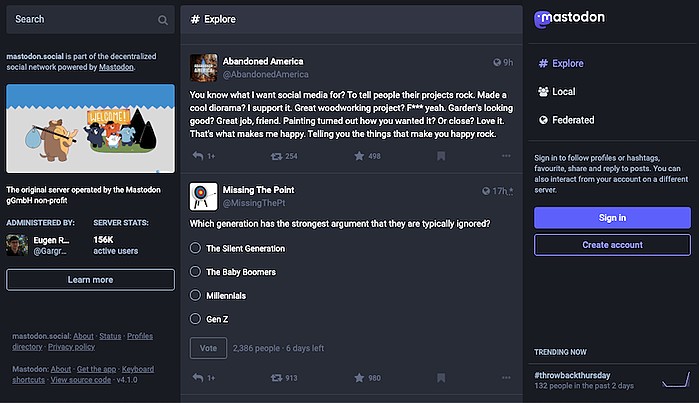A new social network has taken the internet by storm, and it goes by the name of Mastodon. Having amassed a following of almost two million active users by this January, the platform is described as an alternative to Twitter.
So what does this new name have to offer marketers? And can your brand benefit from having a presence on it? In this post, we'll break down what Mastodon is and how to leverage it — according to an experienced and trusted marketing partner here at HubSpot.
What can you do on Mastodon?
On Mastodon, users can explore different servers according to their favorite topics of interest or industry spheres. When you find a forum you're interested in, you can join in and engage with whomever you like — more or less like you would on Twitter. You can:
- Follow users
- Reply to other people's posts
- Engage in or begin your own conversations
You can build a feed tailored to what you want to see and use features like an explore tab to find new and exciting content.
Tips for New Mastodon Users
We asked Crystal King, one of HubSpot's very own Senior Marketing Managers and Principal Inbound Professor, if she had any useful tips for people new to the platform. Here's what she had to say.
-
Put yourself out there and join a variety of servers.
"Like any new social platform you might join, there is a learning curve with Mastodon. The hardest thing to get used to is the idea that not everyone is on the same server as you are, but that you can still talk to them.
"It doesn't really matter what server you are using, but if you want to find a topic-specific server to join then it may mean your local feed is slightly more curated toward that topic, but it's not a necessity to do so."
No one's an expert at something when they first begin. When you join Mastodon, don't feel you belong on only one or two servers. Everyone has a place to share their thoughts and opinions just as much as the next person.
Mastodon has much more freedom of choice regarding the content you're given. While it can recommend conversations and servers to you, it won't crowd your personalized feed with content you haven't followed, like Instagram or Twitter — where recommended, sponsored, or related content can clutter your feed.
2. Find your favorite accounts from Twitter and find where they reside in Mastodon.
"One thing you can do to find your Twitter followers that are also on Mastodon is to go to Twitter and search for the word 'Mastodon.' Then, click the three dots to the right of the search bar and click 'Search filters.' That narrows down the search to only people you follow, and by doing this you can often see tweets where they have shared their Mastodon profiles."
If you're lost on where to start, look at who you already follow on Twitter. Chances are that if they're a full-time influencer or a frequent poster, they may have already made their way to Mastodon — and can help you identify which servers you'd enjoy the most.
3. Don't expect visuals, expect conversations.
"Mastodon is a text-heavy platform, and you won't see many moving .gifs, videos, or big images. Those things are present, but you usually have to click through to see them. Instead, focus on creating and having conversations. Share interesting information. Ask great questions to get people talking. And engage with others. That's where you'll find the most value."
King recommends that new users focus on contributing insightful conversations to gain traction in the platform. While Twitter and Instagram prioritize visual-heavy content, Mastodon will display trending conversations and forums where visuals are more of an added detail than a priority.
Why would a brand want to use Mastodon?
According to King, Mastodon allows marketers to get creative with their digital marketing.
"Brands may feel skeptical about using Mastodon. After all, there are no ads. There aren't any rewards for having a certain number of followers. There aren't any algorithms to push content to more people. In short, it feels like Twitter without all the things that made Twitter great for marketers.
"And that's sort of the point — people don't typically like to be marketed to, and that's what the platform's creators had in mind when developing it. But that doesn't mean brands can't or shouldn't use it. You just can't think about the platform as a replacement for Twitter. It's something different. Mastodon is a place to share information and engage with an audience. And brands that can do that will find a niche on the platform."
Marketers can't rely on paid or promoted ads to reach targeted audiences. Instead, they can use Mastodon to provide value, insight, or content that engages prospects — rather than sell to them.
"The engagement rate on Mastodon is much higher than that of Twitter. Plus, there's a heavy journalist presence on the platform as well, which bodes well for your brand's visibility. If you are a brand that loves chatting with your audience, it may be a great place for you. The best way to find out is to develop a test of three to six months and see how it works for you. Just don't expect it to look or act like Twitter, because it's not."
You can't approach Mastodon expecting the same results as you've gotten from previous social media channels. If anything, King is saying that brands can position themselves for better brand visibility on the platform if they focus on thought leadership — delegating designated content marketers or journalists to post about buzzing conversations and news.
See All the Possibilities Mastodon Has to Offer
With the rise of new social media channels, marketers can use new greenspace to attract prospects. While Mastodon itself isn't directly optimized for paid advertising, there are many ways to grow a following and engage with your target audience.


